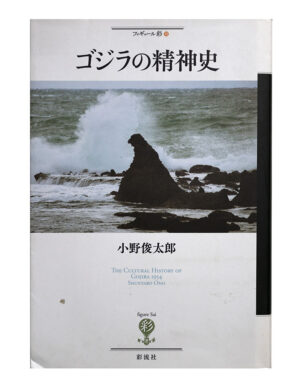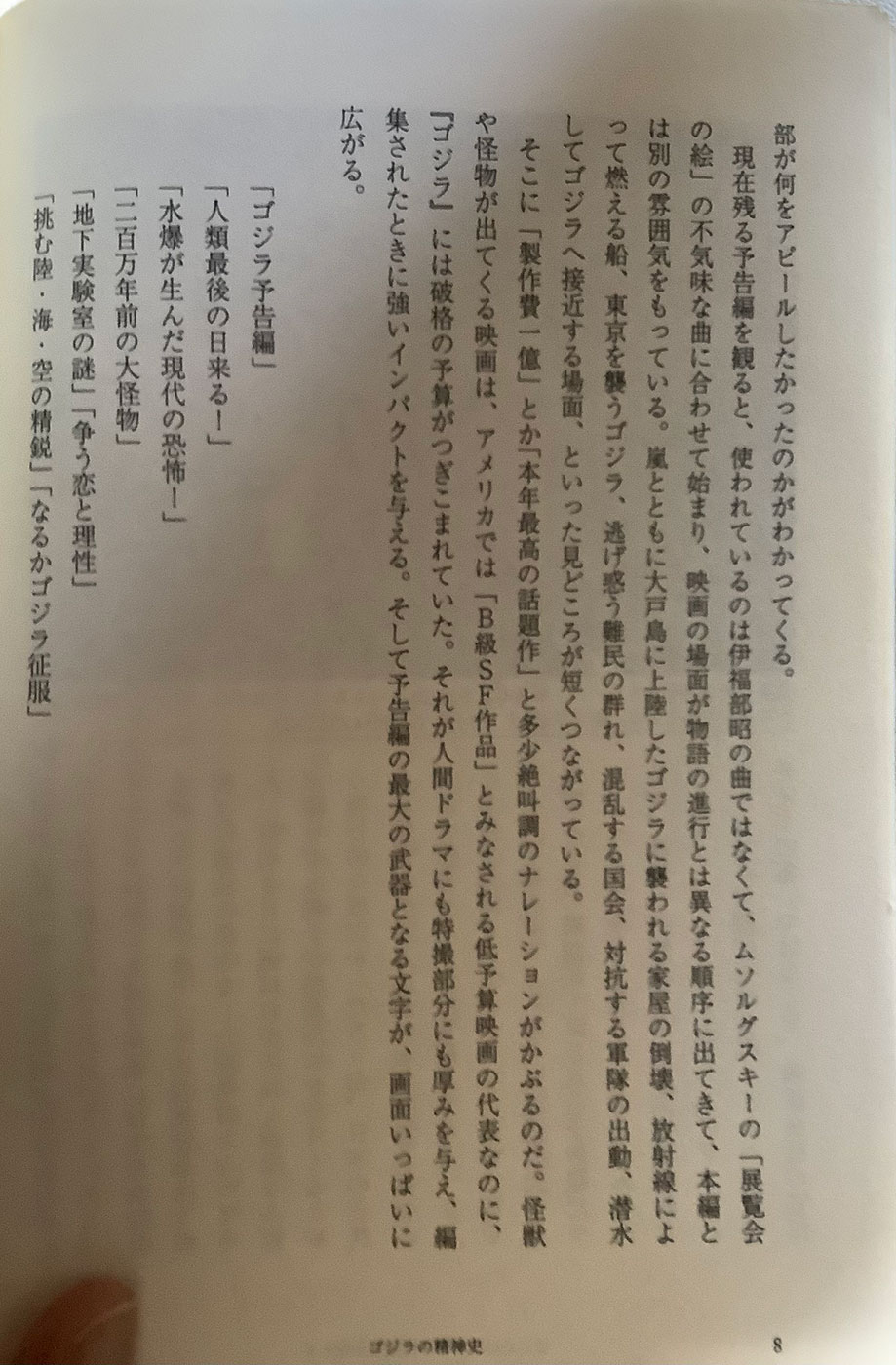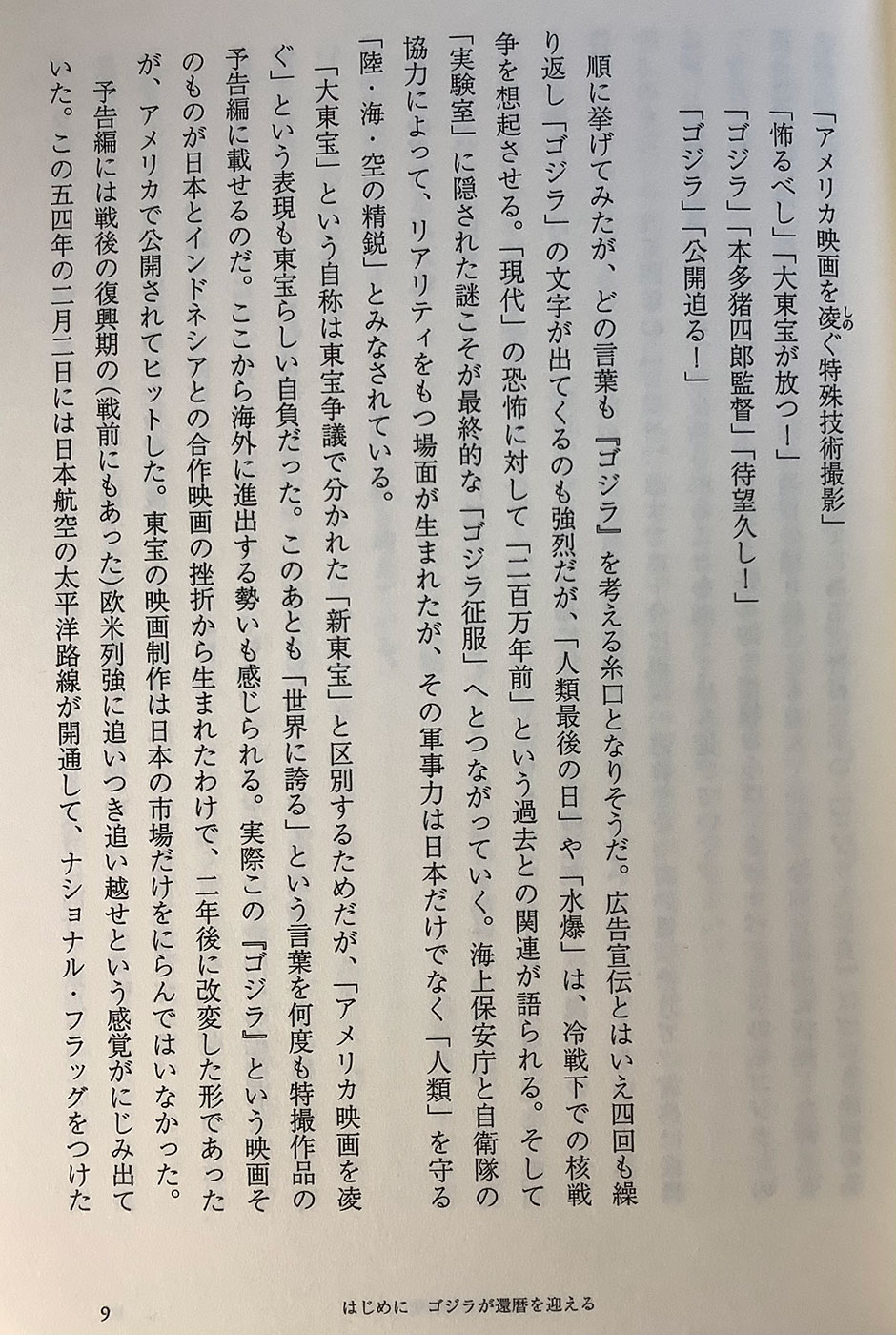9.2.2022
The Cultural History of Godzilla Pt 2


P 8
「アメリカ映画を凌ぐ特殊技術撮影」
“Special technical photography that surpasses American films”
「怖るべし」「大東宝が放つ!」
“Should be scary” “Released by the great Toho!”
「ゴジラ」「本多猪四郎監督」「待望久し!」
“Godzilla” “Directed by Ishiro Honda” “Long-awaited!”
「ゴジラ」「公開迫る!」
“Godzilla” “Opening!”
順に挙げてみたが、どの言葉も「ゴジラ」を考える糸口となりそうだ。広告宣伝とはいえ四回も繰り返し「ゴジラ」の文字が出てくるのも強烈だが、「人類最後の日」や「水爆」は、冷戦下での核戦 争を想起させる。「現代」の恐怖に対して「二百万年前」という過去との関連が語られる。そして「実験室」に隠された謎こそが最終的な「ゴジラ征服」へとつながっていく。海上保安庁と自衛隊の協力によって、リアリティをもつ場面が生まれたが、その軍事力は日本だけでなく「人類」を守る「陸・海・空の精鋭」とみなされている。
I listed them in order, but every word seems to be a clue to thinking about “Godzilla.” Although it is an advertisement, the word “Godzilla” is repeated four times, which is very powerful. The terror of the “modern” is related to the past “two million years ago.” And the mystery hidden in the “laboratory” will lead to the final “Godzilla conquest.” The cooperation between the Japan Coast Guard and the Self-Defense Forces has created scenes with reality, but their military power is regarded as “the elite of land, sea and air” that protects not only Japan but also “humanity.”

P 9
「大東宝」という自称は東宝争議で分かれた「新東宝」と区別するためだが、「アメリカ映画を凌「ぐ」という表現も東宝らしい自負だった。このあとも「世界に誇る」という言葉を何度も特撮作品の 予告編に載せるのだ。ここから海外に進出する勢いも感じられる。実際この「ゴジラ」という映画そのものが日本とインドネシアとの合作映画の挫折から生まれたわけで、二年後に改変した形であった が、アメリカで公開されてヒットした。東宝の映画制作は日本の市場だけをにらんではいなかった。予告編には戦後の復興期の(戦前にもあった)欧米列強に追いつき追い越せという感覚がにじみ出ていた。この五四年の二月二日には日本航空の太平洋路線が開通して、ナショナル・フラッグをつけたダグラス6B 「シティ・オブ・トウキョウ」号が、サンフランシスコに向けて飛び立った(ただし機長はアメリカ人だった)。これを映し出すように、本編では各国からゴジラの調査団が到着する場面で、パンナムなどの海外の航空会社の機体に交じって日本航空の飛行機も登場している。
The self-named “Dai-Toho” was to distinguish it from “Shin-Toho,” which was divided in the Toho dispute, but the expression “surpassing American films” was also a Toho-like pride. Even after this, the words “We are proud of the world” will be put on the trailers of special effects works many times. I can feel the momentum of expanding overseas from here. In fact, the movie “Godzilla” itself was born from the setbacks of a Japanese-Indonesian co-production. Toho’s film production did not focus solely on the Japanese market. The trailer oozes the feeling of catching up with and surpassing the Western powers in the post-war recovery period (which also existed before the war). On February 2, 1954, Japan Airlines opened its Pacific route, and the Douglas 6B “City of Tokyo” with the national flag took off for San Francisco (However, the captain was an American). As if to reflect this, in the main story, when Godzilla’s investigation teams arrive from various countries, Japan Airlines planes appear among the planes of overseas airlines such as Pan Am.
こうした予告編によって断片的ながらも人々の心に刷りこまれた動くゴジラや『ゴジラ』の内容は、公開日を迎えるころには一種の影としてとりついていた。ラジオドラマや子供向けの絵物語など、メディアミックスによる宣伝体制も整って、十一月三日にゴジラを迎える準備はすっかり出来あがっていた。
The moving Godzilla and the contents of “Godzilla,” which were imprinted in people’s minds, albeit fragmentarily, by these trailers, were haunting them as a kind of shadow by the time the release date was approached. With a media mix advertising system in place, such as radio dramas and children’s picture stories, preparations to welcome Godzilla on November 3rd were complete.
ゴジラのグローバル化
Godzilla Globalization
この本では、関連するものにどれだけ話を広げたとしても、あくまでも第一作の映画「ゴジラ」と初代の怪獣ゴジラに話を絞ろうと思う(以下「ゴジラ」といえばこの作品を指す)。還暦を迎えた映画 に敬意を表すだけではなく、「起源」となった作品には、そのときの役割だけでは説明しつくせない要素が眠っているからだ。ひと時の風俗流行として消費されて終わらない体験ができるものを古典と呼ぶのなら、一九五四年の『ゴジラ』はすでに十分に現代の古典となっている。そして、古典は後世に新しい意味を見いだされ、再生産されることを通じて生き延びていく。
In this book, no matter how much I talk about related things, I will try to focus on the first movie “Godzilla” and the first monster Godzilla (hereinafter “Godzilla” refers to this work). This is not only to pay tribute to the film, which celebrated its 60th birthday, but also because the film that became the “origin” has elements that cannot be fully explained by the role at that time alone. If classics are meant to be consumed as a fad for a moment and have a never-ending experience, then 1954’s “Godzilla” is already a modern classic. And the classics survive through being found new meanings in later generations and being reproduced.